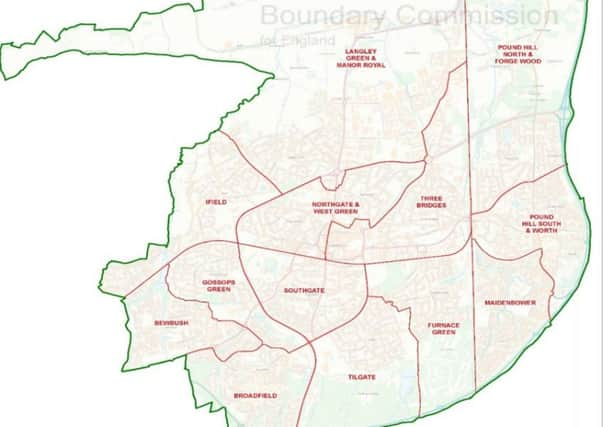Shake-up planned for Crawley council's boundaries


The Local Government Boundary Commission is in the process of carrying out a review which would see changes to a number of the town’s current wards.
A public consultation is now in its final week, with residents having until Monday August 13 to take part.
Advertisement
Hide AdAdvertisement
Hide AdCrawley’s boundary review is one of 39 being carried out across the country, and was triggered after development, particularly at Pembroke Park, in Three Bridges, led to an imbalance in numbers across the wards.
The intention is for each councillor to represent roughly the same number of electors.
Crawley last underwent an electoral review in 2002, when the number of councillors was increased from 32 to 37, and the number of wards from 13 to 15.
If the proposed changes go ahead, the number of wards will go back to 13, ten represented by three councillors and three by two councillors.
Advertisement
Hide AdAdvertisement
Hide AdThe main differences will see Northgate and West Green counted as one ward, with the Northgate boundary ending at Crawley Avenue rather than continuing up into Manor Royal.
The new ward will have three councillors. Each ward currently has two.
The same will happen to Broadfield North and Broadfield South, which will simply become Broadfield and will have three councillors, as opposed to the four currently split equally between the two.
Langley Green will become Langley Green and Manor Royal and will have three councillors, while the Three Bridges ward will expand to include the town centre, and will also have three councillors.
Advertisement
Hide AdAdvertisement
Hide AdFurnace Green, Tilgate and Gossops Green will each have two councillors while all other wards will have three, making a total of 36.
The loss of one councillor could have interesting consequences for Crawley.
Apart from a brief period in 2006/07 when no party had control, the town has always been firmly Labour or Conservative – and there have certainly been some close contests.
In 2004, for example, when the 2002 review came into effect, bringing with it five new seats, Labour held off a Conservative challenge by 19 to 16, with the Liberal Democrats securing two seats.
Advertisement
Hide AdAdvertisement
Hide AdIn 2006, the result flipped, with the figures staying the same but the Tories in control.
In 2007, one seat was settled on the drawing of lots.
Since then, the Lib Dems have fallen off the Crawley radar, leaving just two contenders.
This is a town where no other party or independent have ever been able to get a firm foot in the door.
The only time UKIP was given a look-in was when Conservative councillor Karl Williamson defected in 2013, then resigned a year later, triggering a by-election. His seat went to Labour, finishing ahead of the Tory candidate by 91 votes.
Advertisement
Hide AdAdvertisement
Hide AdSo, with an even number of councillors and no challenge from a third party, will Crawley be seeing more dead heats in the future?
Duncan Crow, leader of the Conservatives, said the review was about ‘what best works for Crawley’.
Mr Crow welcomed the proposal to leave Tilgate, Gossops Green and his own Furnace Green ward with two representatives. But he was not happy with the decision to amalgamate Broadfield North and Broadfield South into one ward, saying he would have preferred a two-way split.
Advertisement
Hide AdAdvertisement
Hide AdMr Crow’s view was shared by Labour leader of the council, Peter Lamb, who explained that it would have been ‘mathematically impossible’ to keep the two wards.
Mr Lamb added: “We did try arguing [with the commission] for more two-member wards but that would have meant having 39 councillors.
“It was the best we could work out while keeping the neighbourhood structure.”
When asked how the changes would affect residents, Mr Lamb said the growing population would mean a bigger workload for the councillors and, as such, it might be more difficult for people to ‘interact with their local representatives’.
Advertisement
Hide AdAdvertisement
Hide AdHe added: “Overall, by the next set of elections, it will mean that your vote is equal to what it is now.”
Mr Crow said the possibility of Crawley Borough Council finding itself with no controlling party was not something the review was required to consider.
He added: “Most councils do tend to have more than two parties and we can’t assume that we’re just going to have two parties representing Crawley Borough Council in the future.”
He added: “If there ever was an 18-18 split, I would be very much open to working together.”
Advertisement
Hide AdAdvertisement
Hide AdInviting residents to have their say on the proposed changes, Professor Colin Mellors, chairman of the commission, said: “This is the last chance for local people to have their say on ward boundaries for all borough councillors in Crawley.
“We want to hear evidence from the people who know Crawley best about the shape of local communities across the borough before we finalise our recommendations in October.”
To take part in the consultation, log on to consultation.lgbce.org.uk/node/11646.
The full recommendations and detailed maps are available on the commission’s main website www.lgbce.org.uk/all-reviews/south-east/west-sussex/crawley.
Responses can be submitted by post to:
The Review Officer (Crawley)
Local Government Boundary Commission for England
1st floor, Windsor House
50 Victoria Street
London SW1H 0TL
Or email [email protected]